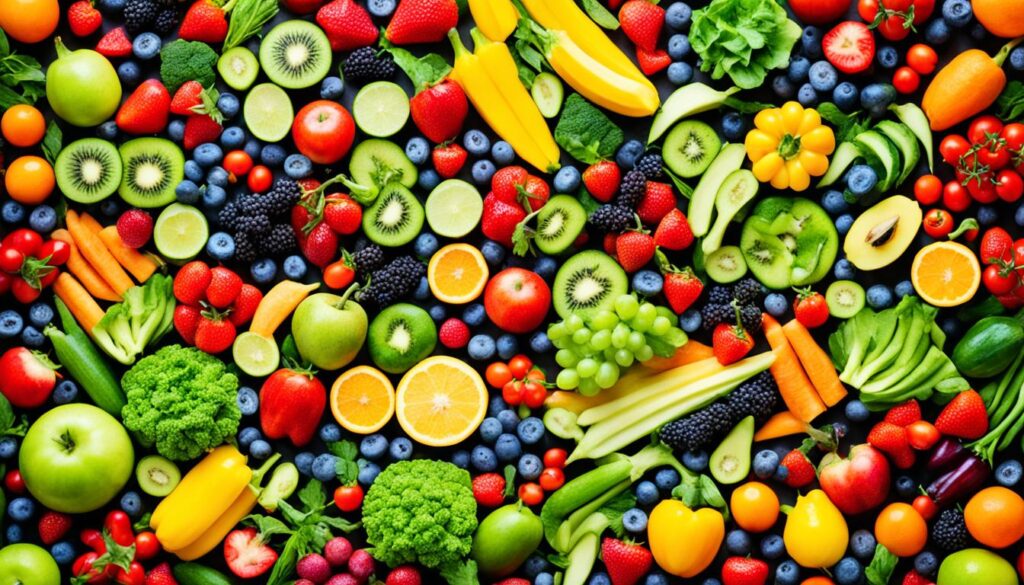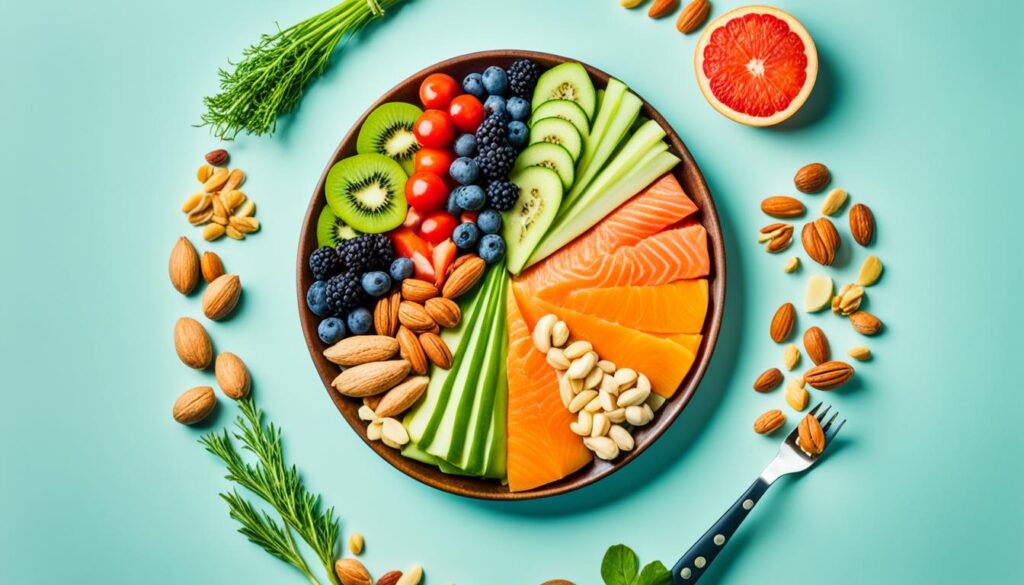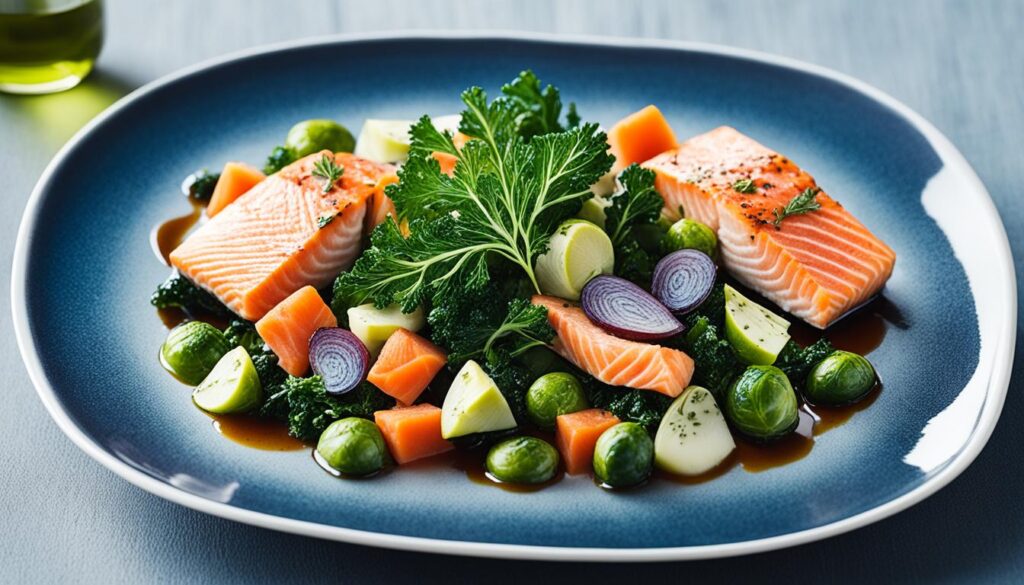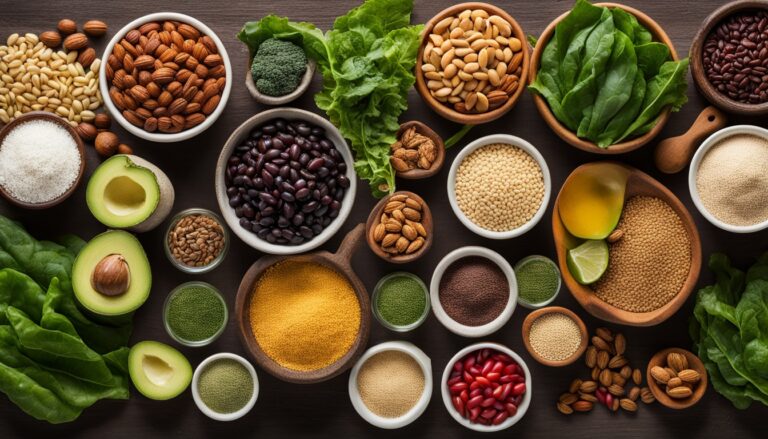Are you tired of weight loss plans that don’t work? Get ready for a game-changer. This article will reveal the top diets for losing fat effectively. But first, let’s ask a question that might change your view on losing weight…
What if losing a lot of fat isn’t just about cutting calories? What if it’s more about the quality and balance of your food? If you’re curious, then get ready to learn about diets that are backed by science. These diets can help you lose fat and improve your health.
Key Takeaways
- Discover the importance of a balanced and sustainable approach to weight loss, beyond fad diets and quick fixes.
- Explore the science-backed diets that can help you shed significant amounts of fat, such as the Mediterranean, DASH, MIND, and Nordic diets.
- Understand the potential benefits of intermittent fasting and ketogenic diets for fat loss and overall health.
- Learn how to create a healthy eating plan that focuses on whole, unprocessed foods and balances macronutrients.
- Discover strategies for sustainable weight loss that combine diet and exercise while addressing lifestyle factors.
What is the Best Diet to Lose a Lot of Fat?
There isn’t just one “best” diet for losing a lot of fat. The best approach is to choose a balanced and sustainable way of eating. Fad diets and quick fixes might help you lose weight at first, but they’re hard to keep up with and can be bad for your health.
Importance of a Balanced and Sustainable Approach
The best weight loss plans are ones you can stick with for a long time. Find an eating plan that includes lots of whole, nutrient-rich foods and lets you enjoy treats in moderation. This way, you’ll lose weight and fat, and you’ll also be healthier overall.
Debunking Fad Diets and Quick Fixes
Fad diets and quick fixes promise fast results but often lack nutritional balance and are hard to keep up with. They can lead to yo-yo dieting and health problems. Instead, aim for healthy eating habits that you can keep up for life.
| Diet Approach | Potential Benefits | Potential Drawbacks |
|---|---|---|
| Mediterranean Diet | – Reduced risk of chronic diseases – Increased life expectancy – Greater weight loss compared to low-fat diets |
– Requires commitment to a plant-based, seafood-rich eating pattern |
| DASH Diet | – Reduced blood pressure – Decreased heart disease risk – More weight loss compared to control diets |
– Requires careful monitoring of sodium intake |
| Plant-Based Diets | – Reduced risk of chronic diseases – Improved metabolic health – Weight loss benefits |
– Potential for nutrient deficiencies if not properly planned |
It’s important to pick an eating plan that you can follow for a long time. Choose one that supports your health and helps you lose weight and fat in a sustainable way.

Understanding Healthy Eating Habits
To lose fat for good, focus on eating whole, unprocessed foods. Eat lots of fruits, veggies, whole grains, lean proteins, and healthy fats. Cut down on added sugars, refined carbs, and unhealthy fats.
Focus on Whole, Unprocessed Foods
Whole, unprocessed foods are key for losing fat. They give you the vitamins, minerals, and fiber your body needs. By choosing whole foods, you avoid empty calories and unhealthy additives in processed foods.
Balancing Macronutrients and Portion Control
It’s also important to balance your macronutrients (protein, carbs, fats) and control your portions. The right mix of these nutrients keeps your energy steady, helps you feel full, and supports fat burning. Watching your portion sizes helps avoid extra calories that can stop your weight loss.
Follow these healthy eating tips every day. You’ll be on your way to losing fat and getting healthier.

“The greatest weapon against stress is our ability to choose one thought over another.” – William James
The Mediterranean Diet: A Proven Approach
The Mediterranean diet is a top choice for losing weight in a healthy way. It focuses on whole foods, healthy fats, and moderate amounts of protein and dairy. This diet is great for your heart, can lower diabetes risk, and may help prevent some cancers.
This diet is easy to follow and focuses on foods that are good for you. Studies show it can lead to more weight loss than other diets like the ADA diet or the keto diet. People who follow this diet often see better results.
In a 12-month study, 259 overweight people with diabetes lost a lot of weight on the Mediterranean diet. Those on the low-carb version lost 22 pounds. The ADA diet group lost 17 pounds, showing how effective the Mediterranean diet can be for weight loss.
The Mediterranean diet does more than help with weight loss. It’s good for your heart, lowers diabetes risk, and supports brain health and longevity. It’s a balanced diet that focuses on plants, healthy fats, and some dairy and protein.

To eat like this, focus on whole foods. Aim for 3 servings of fruits and veggies daily. Also, eat 3 to 6 servings of whole grains and starchy veggies. Use 1 to 4 servings of extra virgin olive oil.
Include 3 servings of legumes, fish, and nuts each week. Poultry, dairy, and red meat should be eaten in small amounts. By following these guidelines, you can improve your health and reach your weight loss goals.
The DASH Diet: A Heart-Healthy Option
The DASH diet is a great way to lose fat and boost overall health. It focuses on eating a balanced mix of fruits, veggies, whole grains, lean proteins, and low-fat dairy. It also limits sodium, red meat, and sugars.
Key Features and Benefits
This diet aims to lower blood pressure and cholesterol, keeping your heart healthy. Studies show it can cut the risk of metabolic syndrome by almost half. It also lowers the risk of cancers like breast, liver, uterus, lung, and colon cancer.
One main part of the DASH diet is controlling sodium intake. The standard plan suggests 2,300 milligrams (mg) of sodium a day. A lower version aims for 1,500 mg. This helps lower blood pressure and can reduce heart disease risk.
The diet also helps with weight loss. A 2020 study found it helped older adults with obesity lose body fat.
“The DASH diet has been shown to reduce blood pressure effectively in numerous studies.”
The DASH diet is a complete and lasting way to live healthier. By eating nutrient-rich foods and avoiding harmful ones, it supports losing fat, heart health, and lowers chronic disease risk.
The MIND Diet: Boosting Brain Health
The MIND diet is a new way to live healthier. It helps with weight loss and makes your brain work better. It combines the best parts of the Mediterranean and DASH diets. It focuses on foods that are good for your brain.
Studies show that the MIND diet can lower the risk of Alzheimer’s disease and improve brain function. Eating more of the right foods and less of the wrong ones helps. This can make your brain work better over time.
The MIND diet tells you to eat less butter and margarine, cheese, red meat, fried foods, and sweets. You should limit these to certain amounts each week. This helps avoid the bad effects of trans fats and processed foods on your brain.
Experts think the MIND diet fights oxidative stress and inflammation in the brain. These are bad for brain health. The diet’s foods are full of antioxidants and anti-inflammatory stuff. This can help prevent dementia and slow down brain aging.

The MIND diet might also help by reducing harmful proteins in the brain linked to Alzheimer’s disease. Eating less saturated and trans fats is part of the diet. These fats are bad for your brain health.
People who followed the MIND diet closely had a 53% lower risk of Alzheimer’s disease. Those who followed it a bit less had a 35% lower risk. They also had better memory, larger brain volume, and slower brain decline.
Trying the MIND diet can help keep your brain healthy and prevent cognitive decline. By adding its tips to your life, you can improve your brain health and weight loss. This lets you live a more active, cognitive function-focused life.
The Nordic Diet: A Cold-Climate Approach
The Nordic diet is a great way to lose fat in a healthy way. It comes from the eating habits of Scandinavia. It focuses on foods from Norway, Denmark, and Iceland.
This diet suggests eating less sugar and more fiber and seafood than usual. It’s all about eating whole, nutrient-rich foods. These foods can help lower the risk of many diseases and help with weight loss.
At the core of the Nordic diet are foods like whole grains, fruits, vegetables, fatty fish, low-fat dairy, and legumes. Game meat is also okay to eat sometimes. It’s leaner than red meat.
The Nordic diet might be hard to follow because of the ingredients. But it’s a good guide for eating well without too much trouble. It balances nutrients and focuses on whole foods. This can help with weight loss and heart health.
| Food Group | Nordic Diet Recommendations |
|---|---|
| Whole Grains | Rye, barley, oats, spelt |
| Fruits and Vegetables | Berries, root vegetables, cruciferous vegetables, dark leafy greens, apples |
| Protein | Fatty fish, lean meat, poultry, eggs, legumes |
| Dairy | Low-fat dairy, such as Skyr yogurt |
| Fats | Canola oil, nuts, seeds |
Following the Nordic diet can lead to sustainable weight loss, better heart health, and a healthier lifestyle.

“The Nordic diet emphasizes an active lifestyle alongside food choices, making it a truly holistic approach to health and well-being.”
Intermittent Fasting: The Science Behind It
Intermittent fasting is a popular way to lose weight. It involves eating and fasting in cycles. This method can help you eat fewer calories, burn more fat, and improve your metabolic health.
Different Fasting Schedules and Methods
There are many ways to do intermittent fasting, each with its own benefits. Here are some common ones:
- The 16/8 method: Eat for 8 hours and fast for 16.
- Eat-Stop-Eat: Fast for 24 hours, once or twice a week.
- The 5:2 diet: Eat normally for 5 days and limit calories to 500-600 on 2 days.
- The Warrior Diet: Eat in a 4-hour window after a 20-hour fast.
Potential Benefits and Drawbacks
Studies show that intermittent fasting can improve insulin sensitivity, reduce inflammation, and boost brain health. According to Mark Mattson, a neuroscientist at Johns Hopkins, it can help manage weight and prevent or reverse some diseases.
But, starting can be tough. You might feel hungry or irritable at first. It’s wise to talk to a doctor before starting, especially if you’re under 18, pregnant, breastfeeding, have type 1 diabetes, or a history of eating disorders.
| Potential Benefits | Potential Drawbacks |
|---|---|
| Improved insulin sensitivity | Difficulty sticking to it in social situations |
| Reduced inflammation | Feeling hungry or cranky when adjusting |
| Potential increase in brain health | Not getting enough nutrients with some methods (like Warrior Diet) |
| Weight loss and management | Not suitable for certain groups (under 18, pregnant/breastfeeding, type 1 diabetes) |
Deciding to try intermittent fasting should be a team effort with a healthcare professional. They can help you consider your needs, preferences, and health goals.
Ketogenic Diets: Exploring High-Fat Approaches
The ketogenic diet is a new way to lose a lot of fat. It’s a high-fat, low-carb diet that puts your body into a state called ketosis. In this state, your body uses fat for energy instead of glucose. This can help with fat burning and weight loss.
This diet is about 70-80% fat, 5-10% carbohydrates, and 10-20% protein. These amounts help keep your body in ketosis. But, it’s hard to keep this balance right, and it might not work for everyone.
- The ketogenic diet limits carbohydrates to less than 50 grams a day, sometimes even 20 grams.
- Studies show it can improve insulin resistance, blood pressure, cholesterol, and triglyceride levels.
- But, the ketogenic diet can cause hunger, fatigue, and nutrient deficiencies if not done right.
The ketogenic diet can help with weight loss, but be careful. It’s important to talk to a healthcare professional before starting. The long-term effects and if it’s good for everyone are still being studied.
“The ketogenic diet can be a powerful tool for weight loss, but it’s not a one-size-fits-all solution. It’s crucial to understand the potential benefits and drawbacks before embarking on this high-fat journey.”
The Harvard Healthy Eating Plate
The Harvard Healthy Eating Plate is a great tool for losing fat and staying healthy. It’s easy to use and based on solid science. Nutrition experts at Harvard created it to help you make healthy meals that meet your health goals.
This plate is divided into sections, each focusing on a key part of a healthy diet. Let’s explore the main parts of this guide:
- Vegetables and Fruits: Fill half of your plate with these foods. They give you vitamins, minerals, and antioxidants that help with health and losing fat.
- Whole Grains: Use a quarter of your plate for whole grains like brown rice and quinoa. They give you complex carbs, fiber, and important nutrients.
- Healthy Proteins: Put a quarter of your plate towards lean proteins like fish and beans. These help build muscle.
- Healthy Oils: Use healthy oils like olive oil for cooking and dressing salads. Limit butter and avoid trans fats.
- Hydration: Drink water, tea, and coffee. Cut down on sugary drinks and too much milk/dairy.
Using the Harvard Healthy Eating Plate makes it easy to make meals that help with fat loss and health. This tool helps you make smart food choices and stick to healthy eating habits.
| Food Group | Recommended Intake | Benefits |
|---|---|---|
| Vegetables and Fruits | Half of your plate | Rich in vitamins, minerals, and antioxidants that support overall health and fat loss. |
| Whole Grains | One quarter of your plate | Provide complex carbohydrates, fiber, and essential nutrients to fuel your body. |
| Healthy Proteins | One quarter of your plate | Help build and maintain muscle mass, which is crucial for fat loss. |
| Healthy Oils | Use in moderation for cooking and dressings | Provide healthy fats that support overall health and heart function. |
| Hydration | Water, tea, and coffee | Maintain proper fluid balance and support overall bodily functions. |
“The Harvard Healthy Eating Plate provides a simple yet effective visual guide for building balanced, nutrient-dense meals that support fat loss and overall health.”
By using the Harvard Healthy Eating Plate, you can make a diet that’s good for losing fat and staying healthy. This guide helps you make smart food choices and stick to healthy eating habits. It’s good for your body and mind.
Sustainable Weight Loss Strategies
Getting rid of weight for good isn’t just about quick fixes or trendy diets. It’s about making a big change that includes eating well and staying active. By doing this, you can lose fat and keep your weight off for good.
Combining Diet and Exercise
For the best results, mix up your diet and exercise plan. Try to lose 1 to 2 pounds each week, which is safe and achievable. Add different types of exercises, like lifting weights and cardio, to increase your metabolism and fitness level.
- Do at least 30 minutes of aerobic exercise most days.
- Do strength training twice a week to keep your muscles strong.
- Eat enough protein, about 5 to 7 ounces daily, to help muscles heal and grow.
Addressing Lifestyle Factors
Weight loss isn’t just about eating right and exercising. Things like managing stress and getting enough sleep are key too. By focusing on these areas, you can make your weight loss journey easier and more lasting.
- Use stress-reducing activities like meditation or yoga to keep your stress levels down and stop overeating.
- Get at least 7 hours of good sleep each night to help your body manage weight.
- Drink lots of water all day to help with digestion and metabolism.
By eating well, exercising regularly, and taking care of your lifestyle, you can lose weight in a way that lasts. This approach will help you enjoy the lasting benefits of being healthier.
Conclusion
Finding the best way to lose fat and keep weight off is not easy. It’s about making lasting changes in your life. This means eating healthy, exercising regularly, and focusing on your overall health. By using the tips and diet plans from this article, you can start a journey to better health and lasting weight loss.
Fad diets might promise quick weight loss, but only 1 to 3 percent of people keep it off for a long time. However, combining exercise with a diet and lifestyle changes can lead to about 7.2 kg of weight loss in 6 months to 3 years.
For the best results, focus on eating nutritious whole foods, controlling your portions, and exercising regularly. This approach can help you achieve your best diet for fat loss, weight loss, and build a healthy lifestyle for long-term success. It’s important to pick an eating and fitness plan that fits your likes and goals. This makes it easier to stick with it for a long time.





